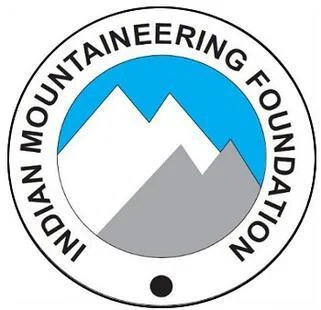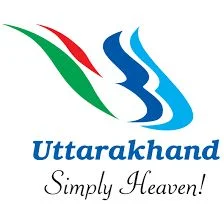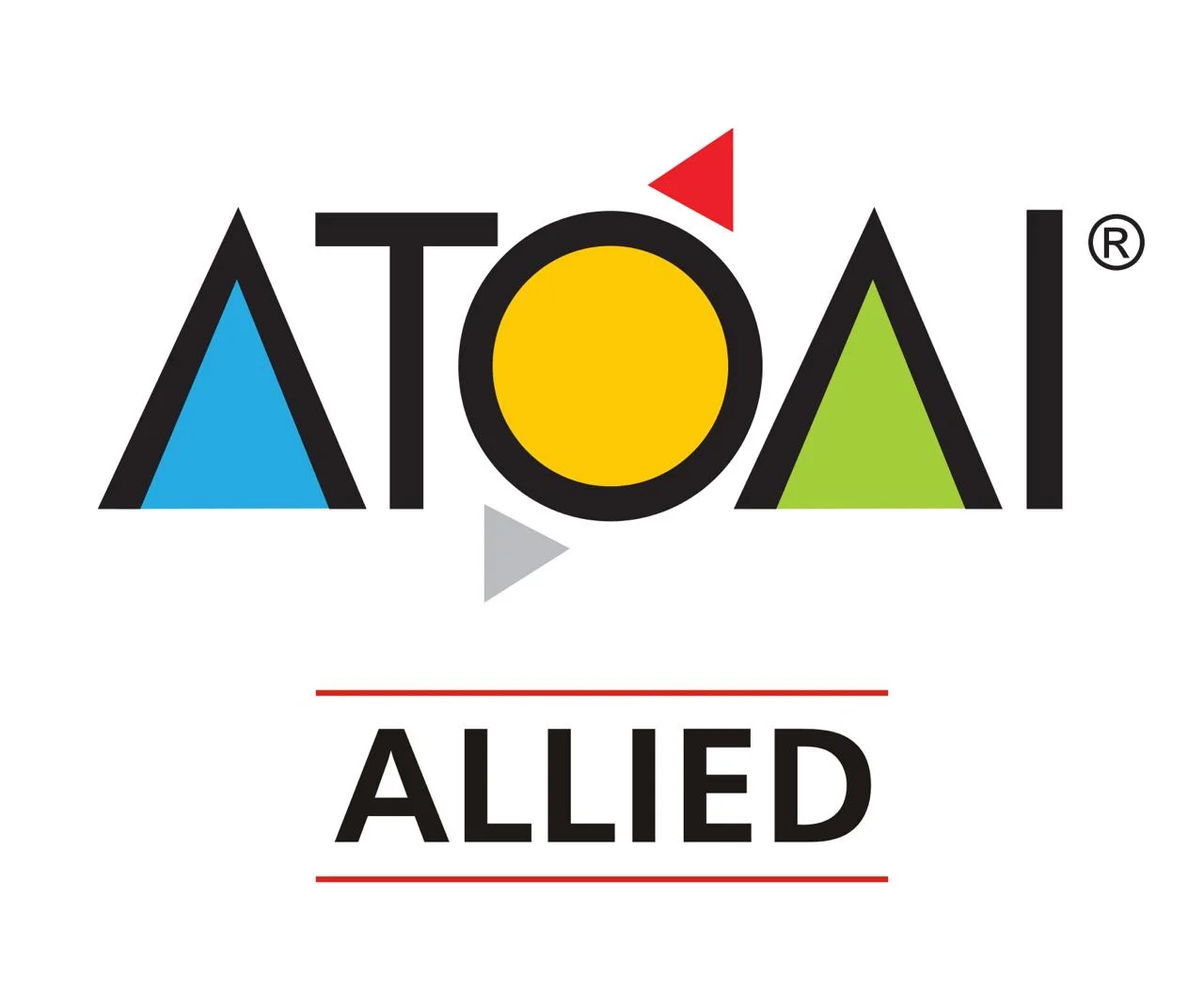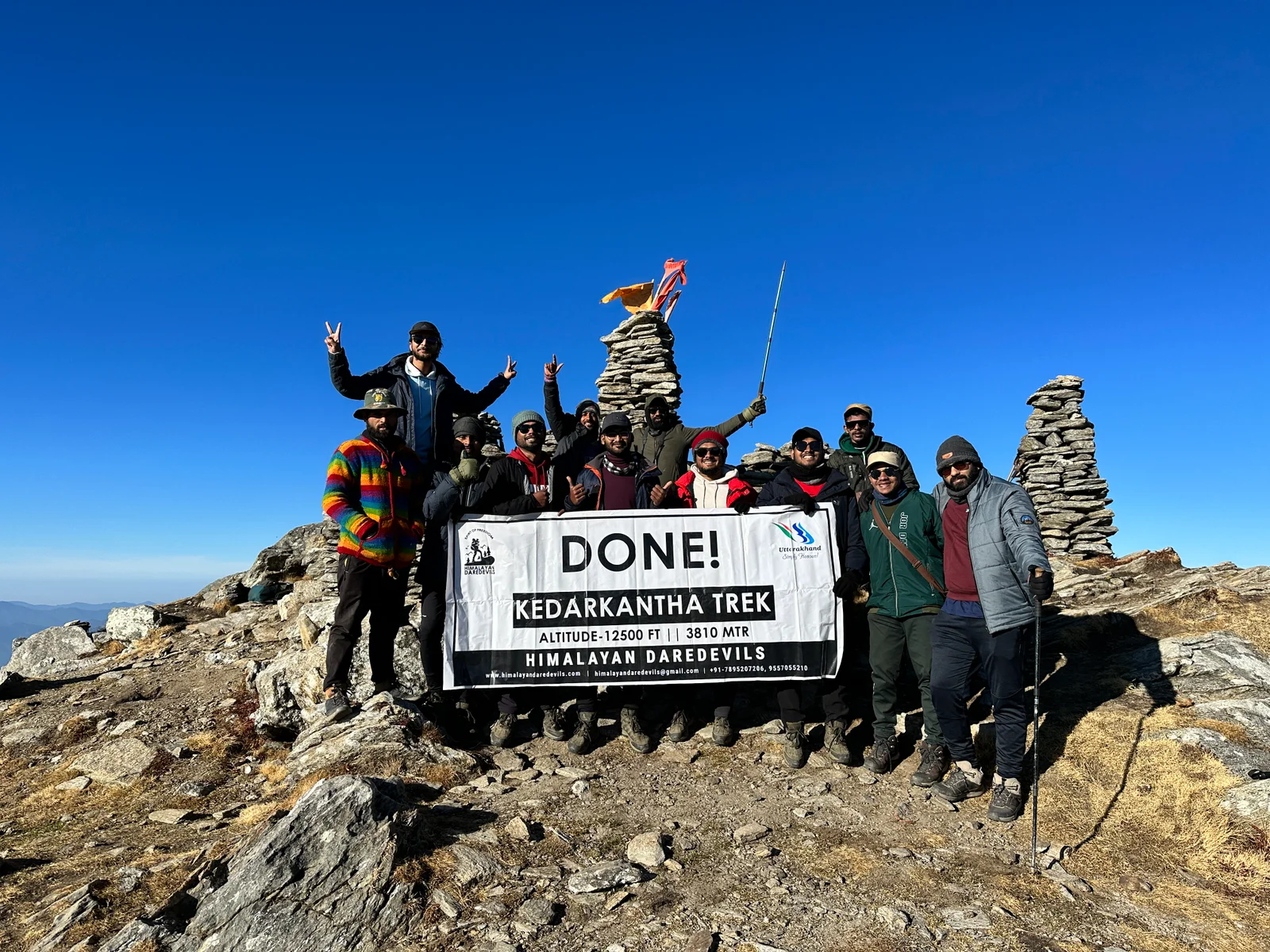Starting From
49,450
43,000.00
Starting From
49,450
43,000.00
Nubra Valley Trek (481+ Reviews)
Trek starts and ends in Leh
Jammu Railway Station
Leh’s Kushok Bakula Rimpochee Airport
Leh
June to September
Leh to Leh
Veg
Camping
Leh
6 Days
Moderate
17716 ft
60 Km
Overview
This trek follows an ancient trade route connecting the Indus and Nubra valleys which was part of the old Silk Road network stretching from India to Central Asia. The trail goes through one of the least visited areas in Ladakh. The beauty of the untouched landscape, the stunning views from the high pass of Lasermo La and the beautiful valley of Hunder Dok will leave you spellbound.
Itinerary
Base Camp of Nubra Valley trek is Leh. Reaching Leh by taking road route consumes a lot of time so board a flight and directly reach there.
Our journey starts from Leh over the World’s highest motorable road (5500 m) which offers great views of Sasar peak and Nubra valley. Go to the village to visit Sumur Monastery, drive back to Disket, there visit famous Disket Monastery.
Reach Hundar, in the evening explore Hundar Monastery get back to camps and retire for the night.
Follow left side of the Hundar River which gently flows through a narrow valley. The trail is zig zag ascend through it and ahead come across villages and fields.
This is Wachan, setup your camps near the field and settle for the day.
Leave Wachan and head to Sarathang. Climb gently and cross Hunda River over the bridge. Towards the left are few Hundar dok huts.
Witness sheep, Yaks, goats and other domestic animals. Reach Sarathang and retire for the night.
Post breakfast, follow the right ascending trail to reach the glacier, the climb is tough through rocky terrain. The glacier rewards you with magnificent views of Stok Kangri summit.
The descent from here is long and reaching Muru dok would take 4 to 5 hours.
It is a beautiful campsite amid two rivers, setup your camps here and retire for the night.
Continue the Markha valley trail passing through tone mills, a destroyed castle and pristine monastery of Techa situated upon a cliff above Markha.
There are several streams on the way before the last settlements of valley.
Leave Umlung village and get first sight of Mt Kang Yatse and the view accompanies us until we reach Kongmaru La.
Have lunch at Hangkar, the last village in the valley then continue hiking to Thochuntse, choose a good ground, setup your tents and retire for the night.
From the campsite, go along the river and cross it further. Start the gradual ascent to Gyamtsa La which lies at an elevation of 4200 m. And, afterwards descend to Gyamtsa and enjoy your journey to Leh.
Nubra Valley Trek Map
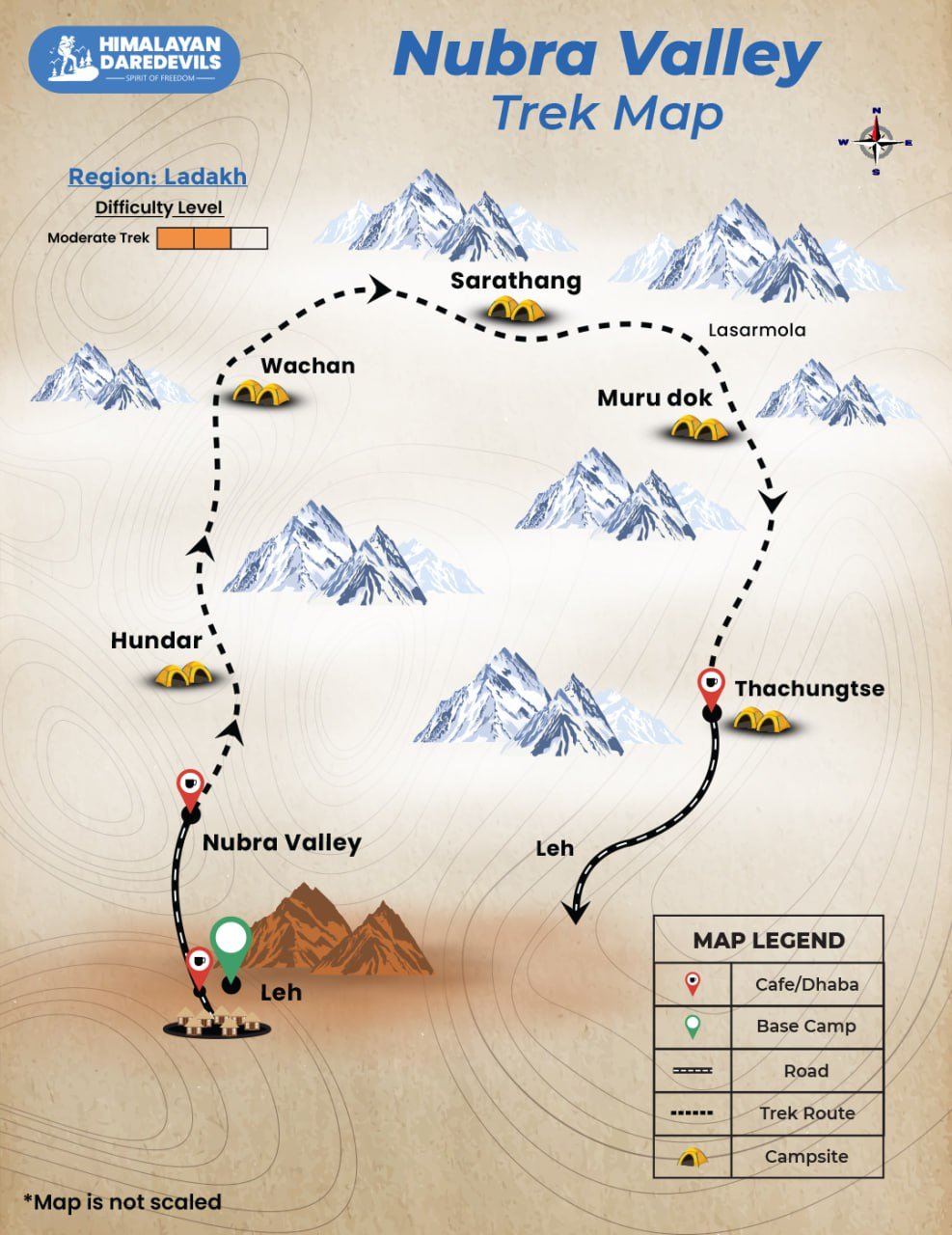
Inclusions
Exclusions
1. Meals while on trek (Veg.).
2. All necessary entry fees and permits.
3. Accommodation:- Guest house / Camping during Trek.
4. Mountaineering qualified & professional trek Leader, guide, cook, and Support staff.
5. First aid medical kits, stretcher, and oxygen cylinder.
6. Trek equipment: Sleeping bag, mattress, tent, kitchen & dining tent, toilet tent, utensils, and crampon (if required)
7. Staff Insurance.
8. Porters/mules to carry central equipment.
1. Any kind of personal expenses.
2. Food during transit.
3. Mules or porters to carry personal luggage.
4. Insurance.
5. Transport (Non Ac)
6. Any kind of emergency evacuation charges
7. 5% GST
8. On first day En Route to base camp the Breakfast and Lunch are Not Included
9. Last Day En Route Lunch and Dinner are Not Included
10 .Any expense incurred or loss cost by reasons beyond our control such as bad weather, natural calamities (landslides, floods), flight delays/rescheduling/ cancellations, any accidents/medical evacuations, riots/strikes/war/pandemics etc.
1. Meals while on trek (Veg.).
2. All necessary entry fees and permits.
3. Accommodation:- Guest house / Camping during Trek.
4. Mountaineering qualified & professional trek Leader, guide, cook, and Support staff.
5. First aid medical kits, stretcher, and oxygen cylinder.
6. Trek equipment: Sleeping bag, mattress, tent, kitchen & dining tent, toilet tent, utensils, and crampon (if required)
7. Staff Insurance.
8. Porters/mules to carry central equipment.
1. Any kind of personal expenses.
2. Food during transit.
3. Mules or porters to carry personal luggage.
4. Insurance.
5. Transport (Non Ac)
6. Any kind of emergency evacuation charges
7. 5% GST
8. On first day En Route to base camp the Breakfast and Lunch are Not Included
9. Last Day En Route Lunch and Dinner are Not Included
10 .Any expense incurred or loss cost by reasons beyond our control such as bad weather, natural calamities (landslides, floods), flight delays/rescheduling/ cancellations, any accidents/medical evacuations, riots/strikes/war/pandemics etc.
What to carry
- Trekking shoes: A good pair of trekking shoes is essential for a comfortable and safe trek. Look for shoes that are sturdy, provide good ankle support, and have a good grip on different types of terrain.
- Backpack with rain cover (50-60 ltr): A backpack is necessary to carry all your gear. Make sure it's the right size for your trek, and comes with a rain cover to keep your belongings dry in case of rain.
- Thermals (upper and lower): Thermals are lightweight and comfortable base layers that help regulate your body temperature in cold weather. Bring both upper and lower thermals to keep warm.
- 3 T-shirts (advisable quick dry): Choose quick-drying T-shirts made from breathable and moisture-wicking materials. This will help keep you cool and dry during your trek.
- 2 trek pants: Choose lightweight and comfortable trek pants that are easy to move in and can dry quickly if wet.
- Jacket (-10 degrees): A warm jacket is essential for cold weather. Choose a jacket that is waterproof and windproof, and provides good insulation.
- Fleece or hood (2): Fleece jackets or hoodies are great mid-layer options to keep warm. Bring at least two, as they can also be used as an extra layer at night.
- Sunglasses (UV protected): Protect your eyes from the sun's harmful UV rays with sunglasses that are designed for outdoor activities.
- Sun cap: A sun cap or hat with a brim will protect your face and neck from the sun.
- Hand gloves: Bring a pair of lightweight gloves to keep your hands warm and protected from wind and sunburn.
- Woolen cap: A woolen cap will keep your head and ears warm at night or in cold weather.
- Socks (3 pairs min): Bring at least three pairs of good quality socks that are moisture-wicking and provide good cushioning and support for your feet.
- Headlamp: A headlamp will come in handy if you're hiking in low-light conditions or need to find your way in the dark.
- Trekking pole (if needed): Trekking poles can help reduce strain on your legs and provide additional support on steep terrain.
- Rain cover\poncho: A rain cover or poncho will keep you and your gear dry during unexpected rain showers.
- Day pack (if you plan to offload your bag): If you plan to offload your backpack during the trek, bring a smaller day pack to carry essentials like water, snacks, and a first aid kit.
- A toiletry kit: Bring a small kit with personal hygiene items, such as a toothbrush and toothpaste, wet wipes, hand sanitizer, and toilet paper.
- Lunchbox, cup, spoon: If you plan to bring your own food, bring a lunchbox, cup, and spoon to carry and eat your meals.
- 2 one-liter bottles: Staying hydrated is crucial, so bring at least two one-liter bottles to carry water.
- 2-3 plastic covers to keep your wet or used clothes: Plastic bags are useful for keeping wet or dirty clothes separate from the rest of your belongings. They can also be used to pack out any trash or waste you generate during the trek.
How to reach
Travel to Leh Ladakh by air
Flying is the fastest and most convenient way to reach Leh. Leh’s Kushok Bakula Rimpochee Airport is a small but well-connected airport that has regular flights from major cities like Delhi, Srinagar and Mumbai. Airlines like Air India, GoAir and Vistara ensure smooth connectivity. The aerial view as you land in Leh is a sight, with snow-covered peaks and endless mountains below you.
But flying directly to Leh has a catch: altitude sickness. The sudden jump to over 11,000 feet above sea level can cause Acute Mountain Sickness (AMS) which gives you headaches, nausea and fatigue. To avoid discomfort, travellers are advised to spend their first day resting and acclimatizing. Hydration and light food can also help alleviate symptoms. Flying is perfect for those who are short on time but want to see the treasures of Ladakh.
Fitness and preparation guide for Nubra Valley Trek
We recommend jogging as the best routine to get fit for a trek. It works on the same muscles that you use while trekking — your calves, glutes and hamstrings. It helps increase your stamina day by day. It is also an easy routine that does not require any equipment or tools.
Fitness target:
To do this trek comfortably, you must be able to cover 5 km in under 35 minutes. This is the minimum fitness required for this trek.
How to achieve this fitness?
- Start jogging at least 4 days a week
- If you cannot run 5 km immediately, start with 2 km and increase to 5 km over 2-3 weeks.
- Once you’re able to run 5 km, increase your pace day by day.
- Gradually increase your pace and bring it down to 5 km in less than 35 mins.
- You must be able to run 5 km in 35 mins consistently for at least 2 weeks before the trek.
This trek requires at least 6-8 weeks of preparation. The longer, the better. So plan your trek soon and start preparing.
Cancellation policy
Life is unpredictable and we understand sometimes you have to cancel or change your trip dates and it is our endeavour to make it as easy possible for you. However, please understand we plan everything including guide fees, permits, accommodation and ration in advance. Therefore any cancellation means inconvenience and certain losses to the people involved in various stages of programme. Keeping that in mind, our cancellation charges are as below-
Cancellation prior to 30 days from start of the event: Get monetary refund with 15% of cancellation charges on trek fee.
Cancellation between 30 days and 15 days to the start of event: 50% on trek fee is non refundable and the remaining 50 % will be given as cash voucher which is valid for 1 year.
Cancellation less than 15 days to the start of event: No refund.
Please note cancellation will be only accepted by email.
Booking amount is non refundable
Note: The Himalayan Daredevils reserves the right to cancel a programme before departure in the event of logistical problems arriving due to natural calamities, strikes, wars on any other circumstances that makes the event inadvisable. In this case, 50% on trek fee is non refundable and the remaining 50 % will be given as cash voucher which is valid for 1 year.
Itinerary changes & trip delays:
We plan itineraries based on the information at the time of planning and in rare circumstances, there are subject to change. In the event that the itinerary is changes or delayed due to unforeseen circumstances such as bad weather conditions, transportation delays, government intervention, landslides etc. We will always aim to give you the best experience possible. However The Himalayan Daredevils are not be held responsible for the cost of delay or changes.
Why Choose Us
